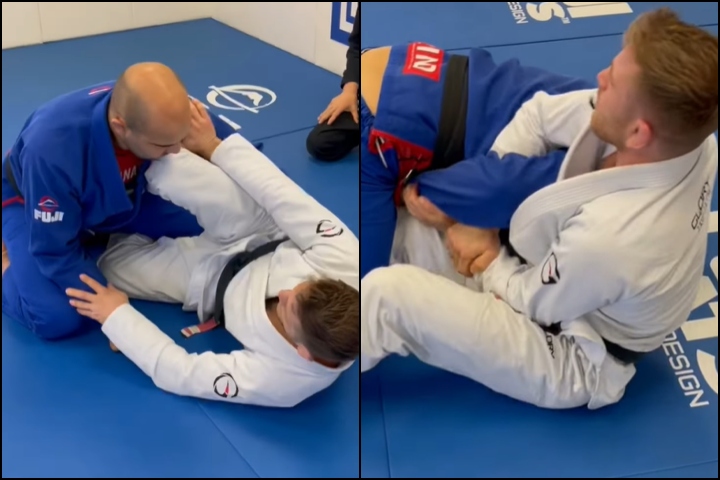Guest post by Evolve MMA, Asia’s premier championship brand for martial arts. It has the most number of World Champions on the planet. Named as the #1 ranked martial arts organization in Asia by CNN, Yahoo! Sports, FOX Sports, Evolve MMA is the top rated BJJ gym in Singapore.
Brazilian Jiu-Jitsu often depicts the idea of “human chess.” It is a sport where both players make moves carefully and constantly counter each other’s movements. While the winner is the one who usually can outthink the other, every action that is performed have different potential responses. These potential responses lead to more options which produce even more possible responses.
Experience enables you to recognize patterns. As you get better, you begin to understand the openings and capitalize on them, rationalizing the next step depending on how the opponent reacts. This makes setting traps a viable option to catch the opponents off guard. This article will talk about when and how to use traps in BJJ.
What Is A Trap In Jiu-Jitsu?
Setting a trap in BJJ means you create a situation and force the opponent into a position that allows you to predict their possible defensive reactions. By catching an opponent in a trap, you are limiting their responses, making your techniques highly effective with a high finishing rate. To put it simply, traps allow you to foresee what the opponent will do as you lay your attacks down.
Gi And No-Gi BJJ Traps
Traps in BJJ can be applied from all positions, standing and on the ground. Below are nine traps you can add to your arsenal to level up your game.
1) Underhook To Guillotine
Starting from side control, let the opponent have the underhook from the bottom. Bait them to come up on top and counter with the guillotine choke. You can snatch their neck and apply the choke as they try to come up on their knees. Initially, you want to allow space and not pin the opponent on the mat. Wait till they grab the underhook, stand up till they’re on their side, and place your hand underneath their chin. You can attack the guillotine and other head and arm choke variations from this position.
2) Cross Collar Choke To Armbar
From the mount, threaten the opponent with the cross collar choke. As they defend and lift their elbow, transition to the armbar. By threatening with your second hand to finish the cross-collar choke on the opponent’s lapel, often they will reach across to block the grip. This forces them to lift their elbow higher, giving you the space to bring your hips higher to their head, providing the perfect position for the armbar. If they don’t defend, continue with the choke.
In most cases, the opponent will protect their neck, though sometimes they may do so together by bridging forward. When this happens, keep the high mount, raise your hips, and start working on the armbar.
3) Armbar To Triangle Choke
The triangle is a submission typically used as a partner to the armbar. To do this, let the opponent come on top from the armbar setup and triangle them as they move up. When you have the opponent in an armbar, you can trap them by letting them come on top and into a triangle by placing your leg (bottom leg) from the armpit side to the shoulder side of the arm. Once you’ve got your opponent’s head inside the triangle, pull the choking leg towards your to finish the choke. It is the natural reaction of the opponent to want to be on top, as it’s easier to escape the armbar from the top position.
4) Omoplata Roll To Armbar
From the omoplata, let the opponent roll out and counter with the armbar as they land on the mat. To counter an omoplata, the opponent often wants to roll out of it. Let the opponent roll, and as they roll, be prepared and ready with the armbar as they land. Make sure you move your knees so the opponent will have room to roll, and as they do, switch to controlling their wrist with both hands.
5) Omoplata To Arm Lock
Let the opponent try and slip their arm out of the omoplata, and as they react, counter with an arm lock. By sticking with the omoplata, the opponent may circle their arm out, and once they circle, come up to your knees and catch their hand in your armpit. Press your hips into their elbow to finish the belly-down arm lock.
6) Baseball Bat Choke
Let them pass your guard to catch the opponent with the baseball choke. From the bottom position, grab the opponent’s lapel, apply the baseball choke grip, and let them pass your guard. As they pass, circle underneath them for the choke. Spinning underneath crosses your arms which creates immense choking pressure. If the opponent takes your back or does an armbar to counter the choke, do not let go of the grip and continue with the choke.
7) Fake Guard Pull To Ankle Pick
Pretend to pull to guard to get the opponent to step forward and counter with the ankle pick. The fake guard pull to ankle pick is an effortless takedown, especially in gi BJJ. By pulling guard, the opponent will naturally step forward, which is what you need to execute the ankle pick. As the opponent steps their lead foot, change your level and grab it with your rear hand. This technique is highly effective for bigger grapplers as it barely requires strength.
8) Hip Bump Sweep To Triangle
From closed guard, force the opponent to post their hand on the mat and counter with the triangle. Make the opponent post on the mat by going for a hip bump sweep. As you come up and attempt the hip bump sweep, grab their head and bring your leg over their arm for the triangle. To do the hip bump sweep, scoot your hips to the side and pull the opponent’s arm to your body and lower your legs to swipe their legs out from underneath. Post your hand on the mat so you can reach the opponent and push them off the mat with your leg to generate power.
Insufficient control over the opponent’s arm will allow them to post on the mat and prevent the sweep. By knowing this, you can let the opponent post out as bait and trap them with the triangle. Make sure to come up for the hip bump sweep, or else the opponent won’t post their hand far on the mat, thereby not giving you enough room to get your leg over their arm.
9) Back Take From The 100 Percent Sweep
From closed guard, let the opponent free their arm from the 100 percent sweep and take their back. In connection to a failed hip bump sweep, you will have the 100 percent sweep to back take by baiting the opponent into freeing their arm so you can take their back as they do. Even if the opponent does not attempt to free their arm, you could let go and transition to the mount or apply a neck crank to submit them.
To perform a 100 percent sweep from a failed hip bump:
- Scoot your glutes out so you can sit up.
- Loop your arm, similar to a guillotine but go through the armpit instead as you lock hands with a gable grip.
- Make space so the opponent can free their arm, and pull them across your body into back control.
Conclusion
BJJ has a variety of moves that lead to discrete positions. As a result of your chosen movements in different decision points, traps worsen the opponent’s situation, making the outcome of the exchange in your favor. Continue working on your game and focus on moves that flow effortlessly together. This will help you become unpredictable on the mats.

















